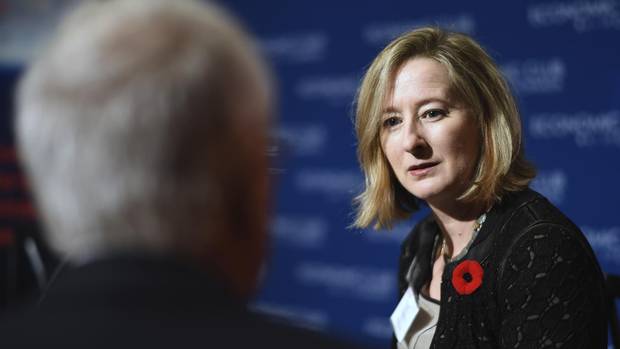The Bank of Canada’s number-two policy maker said the central bank remains confident that Canada’s housing sector will achieve a soft landing, just days after a leading global economic body warned of rising risks in overheated pockets of the Canadian market.
“Our base case, and one that we outlined in the [October Monetary Policy Report], is that the housing market and household debt are going to evolve in a constructive way,” said Carolyn Wilkins, senior deputy governor at the Bank of Canada, in an exclusive interview with The Globe and Mail. “We don’t see the risk as part of our base case at all.”
Earlier this week, the Paris-based Organization for Economic Co-operation and Development warned in its twice-yearly global Economic Outlook that the risk of “a sharp market correction” is rising in Toronto, Canada’s biggest regional housing market. It pointed to a glut of new and unoccupied housing units in the city as a danger sign. It also noted that Canada’s new-home construction starts, which have been trending above a 200,000 annualized rate in recent months, “are running at the higher end of demographic requirements.”
However, the OECD also said that the Toronto and Ontario markets are being supported by “relatively buoyant” economic growth and solid demand from foreign buyers, aided by a weaker Canadian dollar.
Ms. Wilkins argued that Canada’s improving economic momentum will provide a solid base for the housing market, as well as the country’s record levels of household debt, to moderate.
“We see strengthening growth in Canada that’s coming from the U.S., from past monetary policy easing, and also from the lower dollar,” she said from the Bank of Canada’s regional office in Toronto.
“What we are seeing is the rebound in the second half [of 2015] that we were looking for. We’re seeing signs that the exports that you would expect to lead the recovery, that would also be sensitive to changes in the exchange rate, are picking up.”
She reiterated the bank’s outlook that Canada’s output gap – the gap between the economy’s actual output and its full capacity, a key indicator of whether the central bank needs to raise interest rates – should close “some time around mid-2017.”
Ms. Wilkins spoke to The Globe while visiting Toronto for a speaking engagement at the University of Toronto’s Rotman School of Management. Her speech, on Friday morning, focused on the Bank of Canada’s efforts to innovate its operations on many fronts, to meet the fast-evolving nature of central banking and global finance. In her role as second-in-command to governor Stephen Poloz, Mr. Wilkins oversees the bank’s strategic planning.
The speech outlined the bank’s new medium-term plan covering its operations over the next three years – a plan that was released in June, but had received little fanfare as the central bank kept a low profile during the lengthy federal election campaign. One key element to the plan is to better incorporate financial stability risks – such as housing bubbles and household debt levels – into its framework for determining interest-rate policy, something Mr. Poloz and his team have increasingly talked about over the past year.
The central bank also wants to put increased emphasis on its economic research. It will begin publishing a wider range of papers on its website, and will focus more on “timely and topical issues.” (To emphasize the point, the bank posted five new papers on its site Friday in conjunction with Ms. Wilkins’s speech, on topics ranging from housing debt to negative interest rates to financial stability.)
Significantly, the bank is adopting a new publication process in which papers will no longer pass through the bank’s policy-setting Governing Council before publication – a practice that in the past has tended to imply, rightly or wrongly, that the bank’s research reflected the policy leanings of the council. (The Governing Council is composed of Mr. Poloz, Ms. Wilkins and four deputy governors.)
“It’s important that people outside the bank understand what we’re working on when it’s still in the early stages, not when it’s baked into policy,” Ms. Wilkins said in the prepared text of her speech.
“We expect that this kind of work, at times, will show results that are not fully aligned with the views of the bank’s Governing Council. That’s okay,” she said. “The innovation process demands that researchers have the intellectual space to explore ideas.”
DAVID PARKINSON – ECONOMICS REPORTER
The Globe and Mail
Published Friday, Nov. 13, 2015 7:51AM EST
Last updated Friday, Nov. 13, 2015 7:55AM EST


